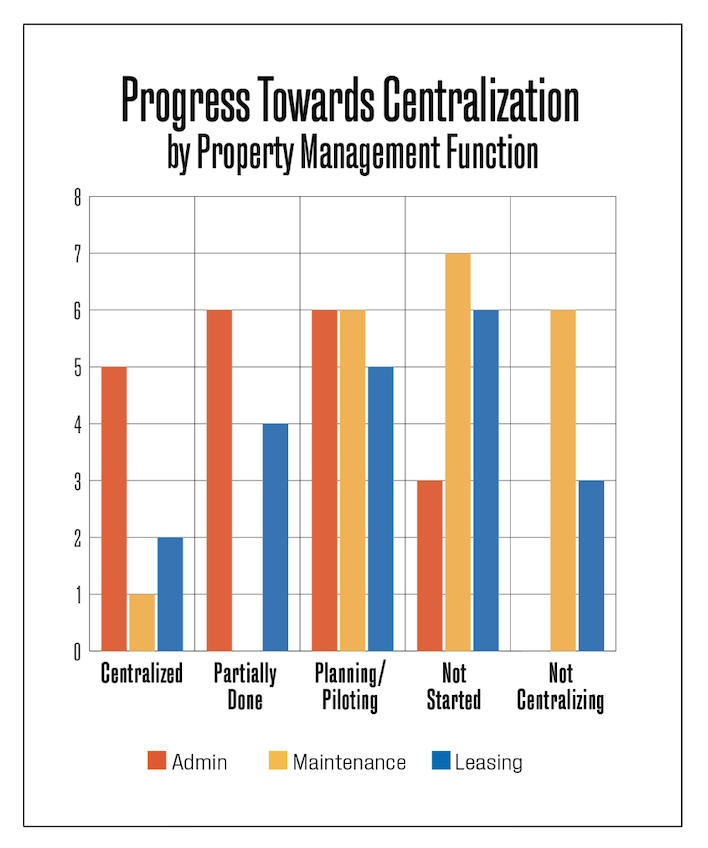Exploring a variety of approaches property management firms are taking as they seek to centralize their property admin functions.
Centralization remains one of the hottest topics in multifamily property management as companies continue to redefine processes and roles in a more technology-enabled operating model. For the last couple of years, the research for the annual 20for20 white paper, which is based on 20 in-depth conversations with 20 operations and technology leaders, has tracked the state of centralization in our industry.

The research has found (unsurprisingly) that “centralization” means different things to different companies. It also found that while most of the industry chatter focuses on centralizing leasing, it is admin processes normally associated with the assistant property manager role that are moving more quickly toward a more centralized future state.
That has been a consistent finding in the last two editions of the 20for20, which tracks progress on three main areas of property management: leasing, admin and maintenance. The most recent edition (released in February 2024) asked the 20 interviewees to describe the centralization of each function on a scale from, “We are not centralizing this function” to, “We have centralized this function.”
The results are instructive. More than half of the companies interviewed had fully or partially centralized property admin functions, significantly outpacing either maintenance or leasing. Perhaps more interesting still is that none of the 20 interviewed companies has opted not to centralize admin functions. By contrast, several of the companies have decided not to centralize leasing or maintenance.
The progress demonstrated between the 2023 and 2024 surveys suggests that at some point in the not-too-distant future, it will be unusual for property management companies to perform admin tasks onsite. As companies continue to move these activities offsite, those persevering with property-based admin will increasingly risk a competitive disadvantage.
The benefits lie not just in increased efficiency: The nature of the work is also changing. Many of the leaders centralizing admin functions are taking the opportunity to reimagine tasks and processes. By focusing repetitive tasks in a more specialized environment, operators can refocus the impact they want site staff to have. This article uses three very different examples to explore the breadth of approaches that companies are taking.
What we mean by ‘property admin’
The scope of work falling under this category tends to include accounting, payments, deposits, collections and, for many companies, renewals. These activities, traditionally associated with the assistant property manager role, seem to lend themselves to centralization.
Marlee Murdock, Director of Operations and Transitions at Western Wealth Capital, says, “I’ve been working in property management for many years, and when we started to look seriously at centralization, we looked at all of the buckets of activity: Leasing, maintenance and admin. Admin was the biggest pain point for us—in a 40-property portfolio, 40 individuals are potentially doing things a little bit differently. We found that even if there are small inconsistencies in standard tasks, we’re leaving money on the table.”
By addressing, for example, move-in and move-out processes, Western Wealth Capital saw there were many fees that, while small at the margin, collectively amounted to substantial savings. Package locker fees never charged to the residents, and incorrect updates to move-in or move-out dates, even if only for a few days, can all amount to considerable lost revenue.
“Deposit accounting is another area that may sound conceptually simple,” says Murdock. “But taking it out of properties and putting it into an enhanced service environment, we now have a handful of specialists that have to be good at this, rather than 40. The number of errors is now extremely low, and the savings are real.”
In addition to specialized teams, technology is handling more tasks and improving experiences. A deposit replacement solution has cut claims down to within 48 hours of move-out and removed most of the work associated with deposits. An AI manages collections, vastly increasing the capacity and the timeliness of the effort.
The AI saves effort, and its use of SMS seems to deliver a better customer experience. “We found just how much more effective SMS is than knocking on doors for an increasingly Gen-Z resident base,” Murdock says. “It’s much friendlier and avoids the embarrassment of having someone call a resident to tell them they haven’t paid their rent.”
Using AI to manage conversations has other applications, with renewals an obvious candidate. “We look at renewals primarily as an admin function, which also benefits from automation,” she says.
“The main benefit of automation is not to do with the likelihood of renewal; it increases the rate at which people decide whether or not to renew. With 48 properties, there is huge potential to let decisions slide, which makes us less certain about exposure. By centralizing and automating, we have greater certainty and make better management decisions.”
Enhancing the personal touch
It is not just the operators with large portfolios who are reaping the benefits of centralizing administrative functions. JC Castillo, founder of Velo Residential—a start-up third-party operator in Texas—believes that centralization of onsite back-office tasks can significantly impact an operation.
“We found that the personal connections our teams make onsite have a greater influence on the multifamily communities we manage,” says Castillo. “By reducing the effort spent on value-creating onsite tasks with AI and virtual admins, our teams could more directly focus on relationship-building, which positively affects performance. We started by shifting back-office tasks like invoice processing offsite. It’s grown to include leasing, resident retention, compliance and more.”
As Velo Residential progressed down this route, a larger opportunity became apparent. Castillo understood (as all good operators do) the importance of regional managers in smooth multifamily operations. But he also noted that they are often burdened with reporting requests from ownership groups.
This approach led to the development of a new centralized admin function called “Customer Success,” modeled after similar roles in the software industry. “We believe it’s highly applicable in our context,” Catillo says. “Customer Success is a fully centralized or virtual role that quickly responds to urgent information requests, cutting regional manager workload and improving the experience for property owners.”
Keeping owners satisfied is essential for third-party managers, and their collaboration is pivotal for the success of centralization. Unlike large owner-operators, third-party managers must adapt these strategies to diverse ownership groups. Jacob Kosior from the Cardinal Group, a 45,000-unit operator with properties in both conventional multifamily and student housing, said, “We can’t approach centralization like some larger industry operators. Our client base is varied, and we need to offer flexible solutions.”
To meet this challenge, the Cardinal Group established a central services team. “Rather than focusing on which property roles to centralize, we considered what an ideal central service provider should look like,” he says. “Unlike companies that move tasks to central locations incrementally, Cardinal has formed a cross-functional central team. This organization allows for better visibility among different departments and greater flexibility in task allocation.”
Kosior says that services offered to operators should align with the unique attributes of individual property portfolios. “We created a menu of options for our partners, allowing them to tailor staffing models that best suit their needs. Whether they prefer the traditional staffing model or something leaner for properties in submarkets with higher densities, we offer a range of choices.”
Start with processes, not people Cardinal’s approach to centralization is instructive for a couple of reasons. First, it is designed to remove the most natural obstacles to centralization. A previous units Magazine article, “Staff Shortages and Centralization: Cause or Coincidence?” explained how two factors determined which companies are candidates for centralization: Control of the operating environment and submarket density.
Public REITs, for example, have complete control of their operating platforms and usually properties that are close enough together to share team members between communities. That creates a model for centralization that is hard for most other companies to copy, as few multifamily operators have both control and proximity. By offering centralized services à la carte, Cardinal offers staffing flexibility to owners, one property at a time.
Second, the driving logic behind their approach is consistent with most of the success stories in multifamily centralization: It is the tasks and the processes that we centralize, not the people. Jobs and organizations change as a result of centralization, and mostly for the better, according to the units article, “Why Centralization Is Good News for Career Paths.” However, it is the process that drives the design of the organization. That is a critical distinction both for organizational design and the careful change management required to turn design into reality.
Western Wealth Capital introduced its new processes with assurances to property staff that compensation and headcounts would remain stable. The process benefits followed, according to Murdock, “Switching to a 100 percent digital format minimizes human error, which is an inherent challenge in property management. When a resident initially opts for a 14-month lease but switches to a 12-month term, the fully digital environment provides natural checks and balances and fewer errors.”
It’s tempting to think about centralization in terms of the relationship between work done and the headcount required to run a building. But as companies progress, they tend to realize that it’s far more nuanced than that. When operators take some tasks off-property, they can think much more broadly about how they perform others.
Western Wealth Capital introduced its new processes with assurances to property staff that compensation and headcounts would remain stable. The process benefits followed, according to Murdock, “Switching to a 100 percent digital format minimizes human error, which is an inherent challenge in property management. When a resident initially opts for a 14-month lease but switches to a 12-month term, the fully digital environment provides natural checks and balances and fewer errors.”
It’s tempting to think about centralization in terms of the relationship between work done and the headcount required to run a building. But as companies progress, they tend to realize that it’s far more nuanced than that. When operators take some tasks off-property, they can think much more broadly about how they perform others.
Western Wealth Capital began its project in Tucson, Ariz., considering it a controlled environment for a project that impacts teams. “It was challenging initially, as relinquishing control goes against the grain, but the enhanced processes broaden our teams’ skill sets and improve service delivery. It’s all about becoming more resident-focused.”
Moving back-office functions to shared services has been normal in most industries for decades. There is no reason why multifamily property operations should be any different. Bookkeeping tasks seldom move the needle on resident experience, and errors come at a cost, as this article has explained.
What is exciting about the examples above is that by re-engineering repetitive processes, operators can reimagine resident experiences. For these reasons, we should expect admin to be at the heart of the centralization journey.
Dom Beveridge is Principal with 20for20, a multifamily technology consultancy.
